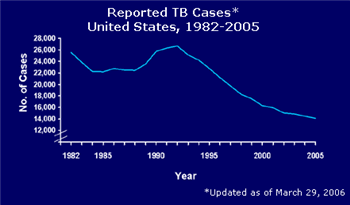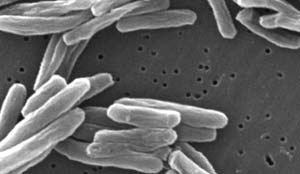On this page:  Tuberculosis – What is it? Tuberculosis – What is it?
Tuberculosis (TB) is a bacterial infection caused by a germ called Mycobacterium tuberculosis. The bacteria usually attack the lungs, but they can also damage other parts of the body. TB spreads through the air when a person with TB of the lungs or throat coughs, sneezes or talks. If you think you have been exposed, you should go to your doctor for tests as soon as possible. You are more likely to get TB if you have a weak immune system. How Does TB Spread? All types of TB (see “Drug-resistant TB” below) are spread the same way. TB germs are put into the air when a person with TB disease of the lungs or throat coughs, sneezes, speaks, or sings. These germs can float in the air for several hours, depending on the environment. Persons who breathe in air containing these TB germs can become infected.TB is not spread by: - Shaking someone's hand
- Sharing food or drink
- Touching bed linens or toilet seats
| - Sharing tooth brushes
- Kissing
- Smoking or sharing cigarettes
|
What are the Symptoms of TB?
Symptoms of TB depend on where in the body the TB bacteria are growing. TB bacteria usually grow in the lungs. TB in the lungs may cause symptoms such as - a bad cough that lasts 3 weeks or longer
- pain in the chest
- coughing up blood or sputum (phlegm from deep inside the lungs)
Other symptoms of active TB disease are - weakness or fatigue
- weight loss
- no appetite
- chills
- fever
- sweating at night
If you think you have been exposed to someone who has TB, call your doctor immediately to schedule a skin test.

Reported TB Cases, United States, 1982-2005. (Source: Centers for Disease Control and Prevention) Since 1992, the incidence of reported cases of TB has declined 47%. The improvement is due to the increased proportion of patients receiving early intervention with testing, drug therapy, and completion of drug treatment. |
How do I get Tested for TB? The most commonly used method to check for tuberculosis is a test referred to as the PPD or TST skin test. The Mantoux tuberculin skin test (TST) is the standard method of determining whether a person is infected with Mycobacterium tuberculosis. The TST is performed by injecting 0.1 ml of tuberculin purified protein derivative (PPD) into the inner surface of the forearm. If you have a positive PPD test, it means you have been exposed to a person who has tuberculosis and you are now infected with the bacteria that cause the disease. What is the Treatment for TB? TB infection and TB disease are not treated the same way. If you have TB infection, you will probably just take INH (Isoniazid) for 6 to 9 months. It is very important that you take all of the medication and not stop because you are feeling better. You should not skip a single dose. If you have TB disease you will take several medicines when you start your treatment to kill the TB germs in your body. These include: Isoniazid (INH), Rifampin, Ethambutol, and Pyrazinamide.
Drug-Resistant TB – What is it? TB can usually be treated with a course of four standard, or first-line, anti-TB drugs. If these drugs are misused or mismanaged, multidrug-resistant TB (MDR-TB) can develop. MDR-TB takes longer to treat with second-line drugs, which are more expensive and have more side-effects. If these second-line drugs are also misused or mismanaged and therefore also become ineffective, extensively drug-resistant tuberculosis (XDR-TB) can develop. Because XDR-TB is resistant to both first- and second-line drugs, treatment options are seriously limited. Drug-resistant TB is caused by inconsistent or partial treatment: - When patients do not take all their medicines regularly for the required period because they start to feel better, or
- Because doctors and health workers prescribe the wrong treatment regimens, or
- Because the drug supply is unreliable.
It is vital that TB control is managed properly by both healthcare professional and their patients. 
| For More Information on TB:
If you wish to read more about TB, try these links: - Health Topics at Medline Plus - This comprehensive online library service from the National Institutes of Health Medical Library (NIHML) offers numerous resources on TB.
- The Division of Tuberculosis Elimination, of the Centers for Disease Control and Prevention (CDC) provides news items, updates, fact sheets, and recent highlights regarding TB and the effort to control and eliminate it.
- State TB Control Offices - The Centers for Disease Control and Prevention (CDC) offers a complete listing of each state office with phone, fax, and Web information.
- The National Institute of Allergy and Infectious Diseases (NIAID) conducts and supports basic and applied research to better understand, treat, and ultimately prevent infectious, immunologic, and allergic diseases. NIAID provides comprehensive information on TB which includes information on TB research, definitions, a visual tour of the TB cells, and more.
- The World Health Organization (WHO) is the directing and coordinating authority for health within the United Nations system. The "Stop TB Department" offers a global view of the mission, policies and directions the organization is taking to develop and implement long-term plans for TB prevention and control.
|
|